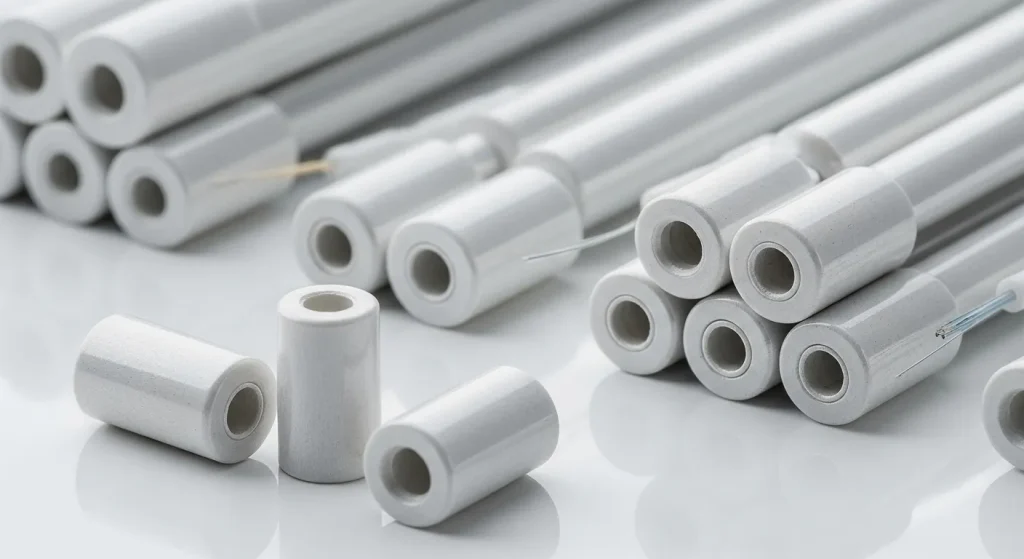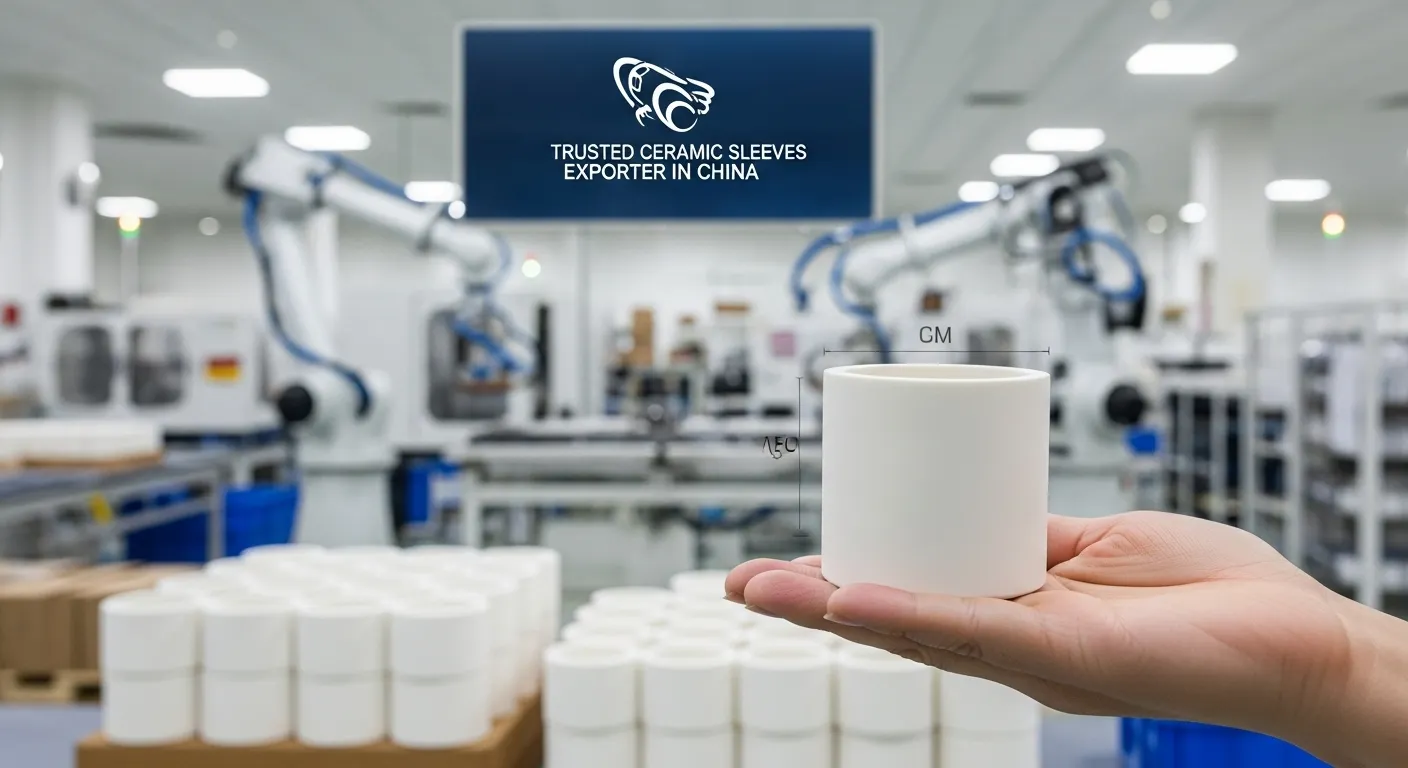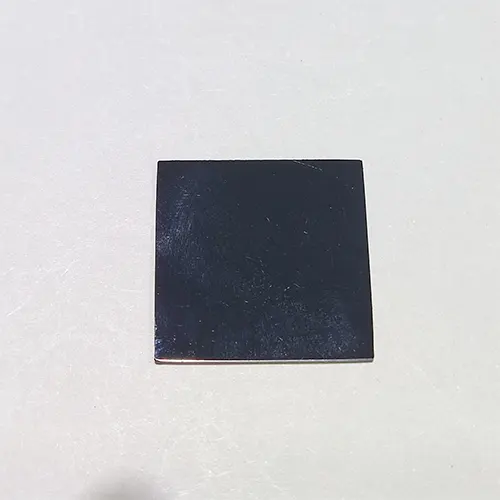Ceramic Ferrules for Fiber Optic Applications
Ceramic ferrules for fiber optic applications are the most critical alignment component in modern data networks. These microscopic, high-precision pins are the heart of every fiber optic connector. Their sole purpose is to hold and align a single, hair-thin optical fiber. The precision of this tiny component is the single most important factor. It determines the performance and reliability of a fiber optic link. A high-quality connection is impossible without a high-quality ferrule.

The entire digital world, from data centers to 5G networks, runs on light. This light is carried through glass fibers. The ferrule is the component that makes it possible to connect these fibers. It ensures light passes from one fiber to the next. This must happen with minimal loss. This article explores the technology, material science, and manufacturing. It details what makes these components so essential. A comprehensive ceramic ferrules guide can provide further background.
What Is a Ceramic Ferrule?
A ceramic ferrule is a precision-engineered cylinder. It is typically made of zirconia. It has a small, hollow channel, or "bore," through its exact center. This component is the primary mechanical part of a fiber optic connector. Its job is to grasp the bare glass fiber. It holds it securely in a process that involves epoxy. The end-face of the ferrule and the fiber are then polished. This creates a single, smooth, unified surface.
The Core Function: Precision Alignment
The ferrule's main job is alignment. A single-mode fiber optic core is incredibly small. It is typically only 9 microns (µm) in diameter. A human hair is about 70 microns. The ferrule must align two 9-micron cores. This alignment must be nearly perfect. Any error, or "misalignment," will cause the light signal to fail.
The Problem It Solves: Insertion Loss
Insertion loss is the primary enemy of a fiber optic network. This is the amount of light, or signal strength, lost at a connection point. It is measured in decibels (dB). The main cause of insertion loss is lateral misalignment. This is when the two fiber cores are not perfectly centered. A high-precision ferrule minimizes this error. It does this by having a hole that is perfectly centered.
The Problem It Solves: Back Reflection
The second problem is back reflection. This is when light is reflected back toward its source. This can corrupt the signal. It can also destroy the laser transmitter. Ferrules solve this in two ways. First, they allow the end-faces to be polished. This polishing creates a "physical contact" (PC) connection. This direct glass-to-glass contact minimizes reflections. Second, ferrules can be polished at an angle. This "angled physical contact" (APC) causes reflected light to bounce away. It does not return to the source.
Anatomy of a Fiber Optic Connector
The ferrule is the key part inside a connector. A typical connector has several parts:
- The Ferrule: The white, ceramic pin that holds the fiber.
- The Connector Body: The plastic or metal housing.
- The Spring: A spring inside the body pushes the ferrule forward. This ensures physical contact.
- The Boot: A flexible boot that protects the fiber-to-cable transition.
The spring-loaded design is critical. It ensures the two ferrules press together with a consistent, controlled force.
The Material Science: Why Zirconia is the Standard
Ceramic ferrules for fiber optic applications are made from one material. This material is Yttria-Stabilized Zirconia (Y-TZP). This is not a household ceramic. It is an advanced technical ceramic. It was chosen because it has a unique combination of properties. No other material offers this perfect balance.
An Introduction to Yttria-Stabilized Zirconia (Y-TZP)
Zirconia is a ceramic oxide (ZrO2). In its pure form, its crystal structure changes with temperature. This makes it unstable. To solve this, a small amount of Yttrium Oxide (Yttria) is added. This yttria locks the zirconia into a stable, tetragonal crystal structure. This process is called "stabilization." The result, Y-TZP, is one of the most advanced engineering materials.
Key Property 1: Extreme Hardness and Durability
Zirconia is exceptionally hard. It has a hardness of around 8.5 on the Mohs scale. This is much harder than steel. This hardness is vital for the ferrule's end-face. It means the polished tip will not scratch or deform. A connector can be mated and un-mated thousands of times. The ferrule's surface will not wear down. This ensures a long, reliable life.
Key Property 2: High Fracture Toughness
This is zirconia's most unique trait. Most ceramics, like a dinner plate, are brittle. They shatter when dropped. Zirconia is different. It is "tough." It can absorb stress and impact. This is due to a process called "transformation toughening." If a micro-crack forms, the zirconia crystal structure changes at the tip of the crack. This change absorbs the energy and stops the crack from growing. This toughness is essential. The ferrule is a small, thin-walled part. It must withstand the constant force of the spring.
Key Property 3: Thermal Stability
This is the most important property for performance. Zirconia has a coefficient of thermal expansion of around 10 x 10⁻⁶/°C. This is very close to that of the glass optical fiber. This similarity is critical. It means that as the equipment heats up and cools down, the ferrule and the fiber expand and contract at almost the same rate. This prevents the fiber from breaking. It also stops "pistoning," which would create a gap and kill the signal.
Key Property 4: Chemical Inertness and Stability
Zirconia is a stable oxide. It does not rust, corrode, or react with moisture. This ensures the component will have a long, reliable life. It will perform for decades in any environment.
Why Other Materials (Metal, Plastic) Failed
Early connectors used different materials.
- Metal Ferrules: These were often made of stainless steel. They had two problems. They were much softer than zirconia, so they scratched easily. They also had a high thermal expansion. This caused the fiber to break or piston with temperature changes.
- Plastic Ferrules: These are very cheap. They are also very imprecise. They are sometimes used for multimode fiber, which has a larger core. They are not suitable for single-mode precision.
Zirconia solved all of these problems. It is the undisputed material of choice.
The Manufacturing Process: A Feat of Precision
The creation of a ferrule is a feat of ceramic engineering. It is a multi-stage, high-control process. It turns a raw powder into a sub-micron component.
Step 1: Material Formulation
The process begins with an ultra-pure, nanoscale Y-TZP powder. This powder is mixed with a proprietary polymer binder. This creates a feedstock material. The binder acts as a temporary "glue" that allows the powder to be molded.
Step 2: Ceramic Injection Molding (CIM)
The feedstock is heated until it has a paste-like consistency. It is then injected under very high pressure into a steel mold. This mold has the shape of the ferrule. It is, however, about 20% larger than the final part. This is to account for shrinkage. This molding process creates the "green part."
Step 3: Debinding
The green part is a mix of ceramic powder and polymer. The binder must be removed. This is done in a debinding furnace. The part is heated very slowly. This process carefully burns away the polymer binder. This must be done gradually. If heated too fast, the part will crack.
Step 4: Sintering
The part is now just porous zirconia. It is placed in a high-temperature furnace. It is heated to over 1,400°C. At this heat, the zirconia particles fuse. The part shrinks by a precise, calculated amount. It becomes incredibly hard, dense, and stable. Controlling this sintering process is key to achieving the final dimensions.
Step 5: Precision Grinding
After sintering, the ferrule is hard, but its dimensions are not yet perfect. It must be finished. A centerless grinder is used. This machine uses diamond wheels. It grinds the outer diameter to its exact 2.5 mm or 1.25 mm size. The tolerance is often ±0.0005 mm (half a micron).
Step 6: The Sub-Micron Bore
This is the most difficult and proprietary step. The microscopic hole in the center must be finished. A precision wire, coated in diamond slurry, is often used. It "laps" the inner hole. It removes material one nanometer at a time. This step establishes the final inner diameter. It also ensures the hole is perfectly straight.
Step 7: Final Polishing and End-Face Geometry
The final step is to create the end-face geometry. The end of the ferrule is lapped. This creates the flat (for APC) or domed (for PC) shape. This is done by the ferrule manufacturer. The final, mirror-like polish of the fiber and ferrule is done by the connector assembler.
Critical Specifications of a High-Precision Ferrule
Ceramic ferrules for fiber optic applications are defined by their numbers. Quality is not subjective. It is a set of verifiable, sub-micron measurements.
Standard Outer Diameters: 2.5 mm vs. 1.25 mm
There are two dominant ferrule standards.
- 2.5 mm Ferrules: This is the older, larger standard. It is the-pin used in SC, ST, and FC connectors. These are known for their robust, durable nature.
- 1.25 mm Ferrules: This is the smaller, modern standard. It is used in LC and MU connectors. Its small size allows for very high-density connections. This makes it the standard for data centers.
Inner Diameter (ID) Tolerance
The hole for the fiber must be perfect. For a 125-micron fiber, the hole is typically 126 microns. This provides a snug fit. The tolerance on this 126-micron hole is just ±1.0 µm. Some grades are even tighter, at ±0.5 µm.
Concentricity and Eccentricity
This is the most important specification for performance. Concentricity is the measure of how centered the ID (the hole) is relative to the OD (the ferrule body). Any offset is called eccentricity. This eccentricity directly causes the fiber cores to be misaligned.
- Standard Grade: May have an eccentricity of 1.0 µm or more.
- Premium Grade: Will have an eccentricity of < 0.7 µm.
- Ultra Grade: Will have an eccentricity of < 0.5 µm.
A top supplier must be able to provide these premium grades.
End-Face Geometry: PC, UPC, and APC
The ferrule tip is polished to a specific shape.
- PC (Physical Contact): A slightly domed end. This ensures the fiber cores touch.
- UPC (Ultra Physical Contact): A finer polish for a better connection.
- APC (Angled Physical Contact): The end is polished at an 8-degree angle. This is the green connector. The angle causes any reflected light to bounce out of the fiber. This is essential for video and high-speed data.
The Role of Metrology
These specifications are measured with advanced tools.
- Air Gauges: These are used to measure the ID.
- Video Inspection Systems: These high-speed cameras measure concentricity.
- Interferometers: These are used to check the end-face geometry after polishing.
The Global Supply Chain for Ceramic Ferrules
The market for ferrules is global. A component made in one region is used in another. A reliable supply chain is essential.
Sourcing in High-Specification Markets
Mature markets demand the highest quality. A supplier for ceramic ferrules USA must meet strict standards. This is for data centers, medical, and defense. The same is true for ceramic ferrules Europe. These markets prioritize reliability and compliance.
Sourcing in High-Growth Markets
Rapidly expanding networks also need quality. A supplier for ceramic ferrules Indonesia is vital. They support the growth of new data centers and broadband.
The Role of a Quality Supplier
A top supplier is more than a reseller. They are a quality partner. They vet manufacturers. We hold local inventory. They provide technical support. They ensure every ferrule they sell meets its stated specifications.
Conclusion
The ceramic ferrule for fiber optic applications is an unseen component. It is a tiny, inexpensive part. Yet, it is the foundation of our entire digital world. Its performance is not magic. It is the result of advanced material science. It is the result of a perfectly controlled manufacturing process. The move to zirconia, with its hardness, toughness, and thermal stability, was the key. This component allows us to connect the world at the speed of light.
 English
English 中文
中文





